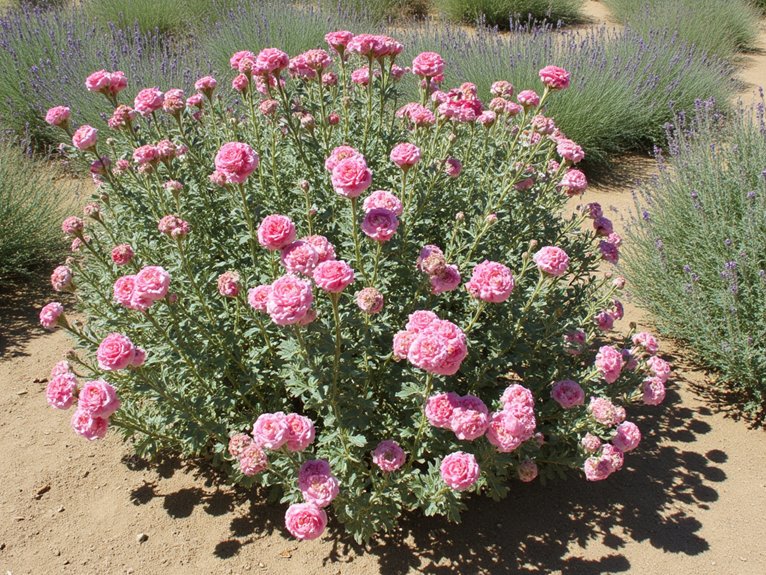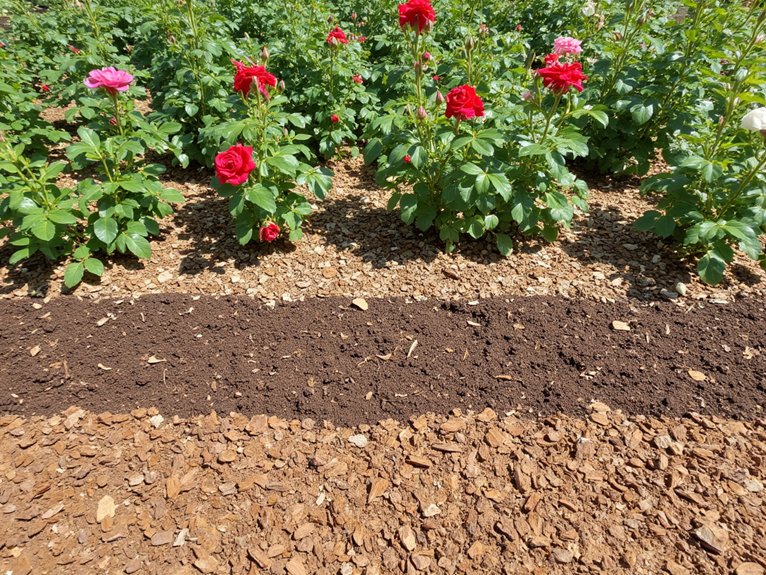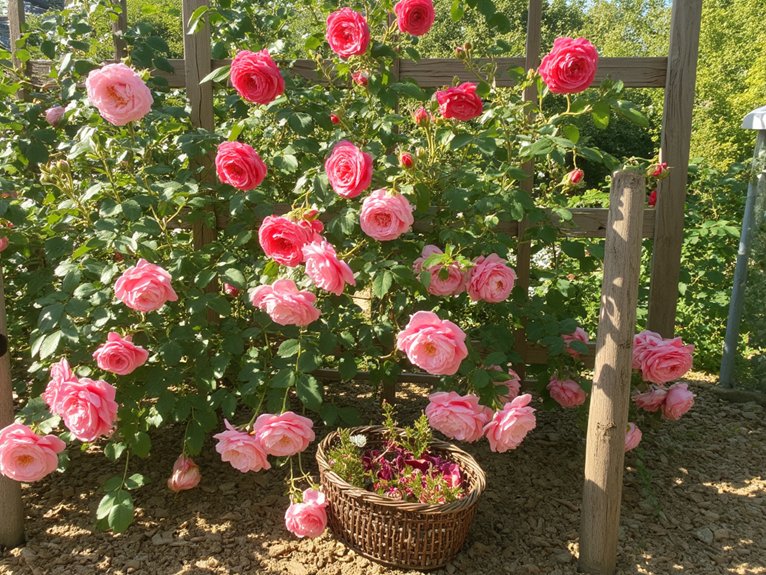Growing drought-resistant roses opens up exciting possibilities for gardeners in arid regions. These hardy cultivars have evolved specialized features like waxy leaves and extensive root networks that help them flourish with minimal water. According to rose expert Michael Marriott, “Desert-adapted roses can thrive on 70% less water than traditional varieties while producing equally stunning blooms.” The key lies in selecting the right varieties and implementing proper techniques for success in challenging environments.
Contents
Understanding Drought-Tolerant Roses

Why do some roses thrive in dry conditions while others wilt at the first sign of drought? The answer lies in their genetic makeup and root structure. Expert gardener Danielle Sherwood explains that drought-tolerant varieties develop deeper root systems and more efficient water uptake mechanisms.
Successful rose selection depends on understanding drought symptoms and local climate conditions. While hybrid teas struggle in arid environments, species like Rosa rugosa ‘Hansa’ and ‘Iceberg’ flourish. These resilient varieties demonstrate natural adaptations including:
- Waxy leaf coating to prevent moisture loss
- Compact growth habits
- Extensive root networks
- Higher tolerance for temperature fluctuations
Essential Watering Techniques
Three key principles govern effective watering techniques for drought-resistant roses: timing, depth, and frequency. Morning watering reduces evaporation loss, while deep watering encourages robust root development essential for drought survival.
Expert gardener Danielle Sherwood recommends: “Water deeply once weekly rather than daily light sprinklings. This trains roses to develop drought-resistant root systems.”
Successful drought strategies include:
- Water at soil level, avoiding foliage
- Apply 1-2 inches of water per session
- Check soil moisture 6 inches deep
- Maintain 2-3 inches of woodchip mulch
- Adjust frequency based on seasonal temperatures
Soil Preparation and Mulching Strategies

Proper soil preparation and strategic mulching form the foundation for drought-resistant rose success. Gardeners should incorporate organic soil amendments like compost and aged manure to a depth of 12 inches before planting. This improves both drainage and moisture retention capacity.
For mulch types, woodchips prove most effective for roses, maintaining consistent soil temperatures and reducing water evaporation. Apply a 3-inch layer around plants, keeping mulch several inches away from stems. “Quality mulch acts as a protective blanket,” notes expert Danielle Sherwood, “reducing water needs by up to 50% while gradually enriching the soil.”
Top Rose Varieties for Arid Climates
While many roses struggle in hot, dry conditions, several exceptional varieties have evolved to thrive with minimal irrigation. Notable drought-resistant varieties include the ‘Iceberg’ rose, growing 4-12 feet tall with pristine white blooms, and ‘Lemon Fizz’, a compact 3-4 foot shrub producing vibrant yellow flowers from spring through fall.
These resilient roses showcase distinct characteristics throughout their blooming seasons. The fragrant ‘Hansa’ displays magenta blooms on 5-7 foot bushes, while ‘Orange Freedom’ offers striking apricot flowers on 4-6 foot stems. For lower maintenance gardens, ‘Perle d’Or’ provides reliable pale buff blooms at 4-5 feet tall.
Seasonal Maintenance and Care

Successfully maintaining drought-resistant roses throughout the seasons requires strategic timing of essential care tasks. Garden expert Danielle Sherwood recommends a seasonal approach:
Spring:
- Apply 2-3 inches of compost around plant bases
- Implement pest management through weekly inspections
- Fertilize with balanced organic nutrients
Summer:
- Water deeply at root level before 9am
- Monitor for disease symptoms
- Maintain 3-inch woodchip mulch layer
Fall:
- Practice selective pruning techniques
- Remove spent blooms
- Clean debris from base
Winter:
- Reduce watering frequency
- Check mulch coverage
- Protect from frost as needed
Companion Plants for Water-Wise Gardens
Creating a vibrant water-wise garden involves pairing drought-resistant roses with compatible companion plants that share similar moisture needs. Effective companion planting supports water conservation while enhancing the garden’s visual appeal.
Gardeners can combine roses with:
- Lavender varieties for fragrant, drought-tolerant borders
- Deep purple salvias to create striking color contrasts
- Low-growing sedums for ground cover
- Butterfly-attracting coreopsis for seasonal interest
- Native yarrow species for extended blooms
“Select plants with similar water requirements to maintain consistent irrigation patterns throughout the garden,” advises horticulturist Danielle Sherwood. These combinations create sustainable, low-maintenance landscapes that thrive in arid conditions.
Design Tips for Desert Rose Gardens
Desert rose gardens require thoughtful planning to create stunning displays that thrive in arid conditions. Effective designs incorporate varying heights, from low-growing Coral Drift roses at 2.5 feet to towering American Pillar climbers reaching 24 feet. Strategic placement creates visual layers and depth.
Color schemes play an essential role in desert garden aesthetics. Expert gardener Danielle Sherwood recommends combining complementary hues: “Plant clusters of white Icebergs with deep purple Hansias, or pair orange Freedom roses with yellow Lemon Fizz varieties for dramatic impact.” Pathways and seating areas should weave through these thoughtfully arranged groupings, allowing visitors to fully appreciate the garden’s beauty.
